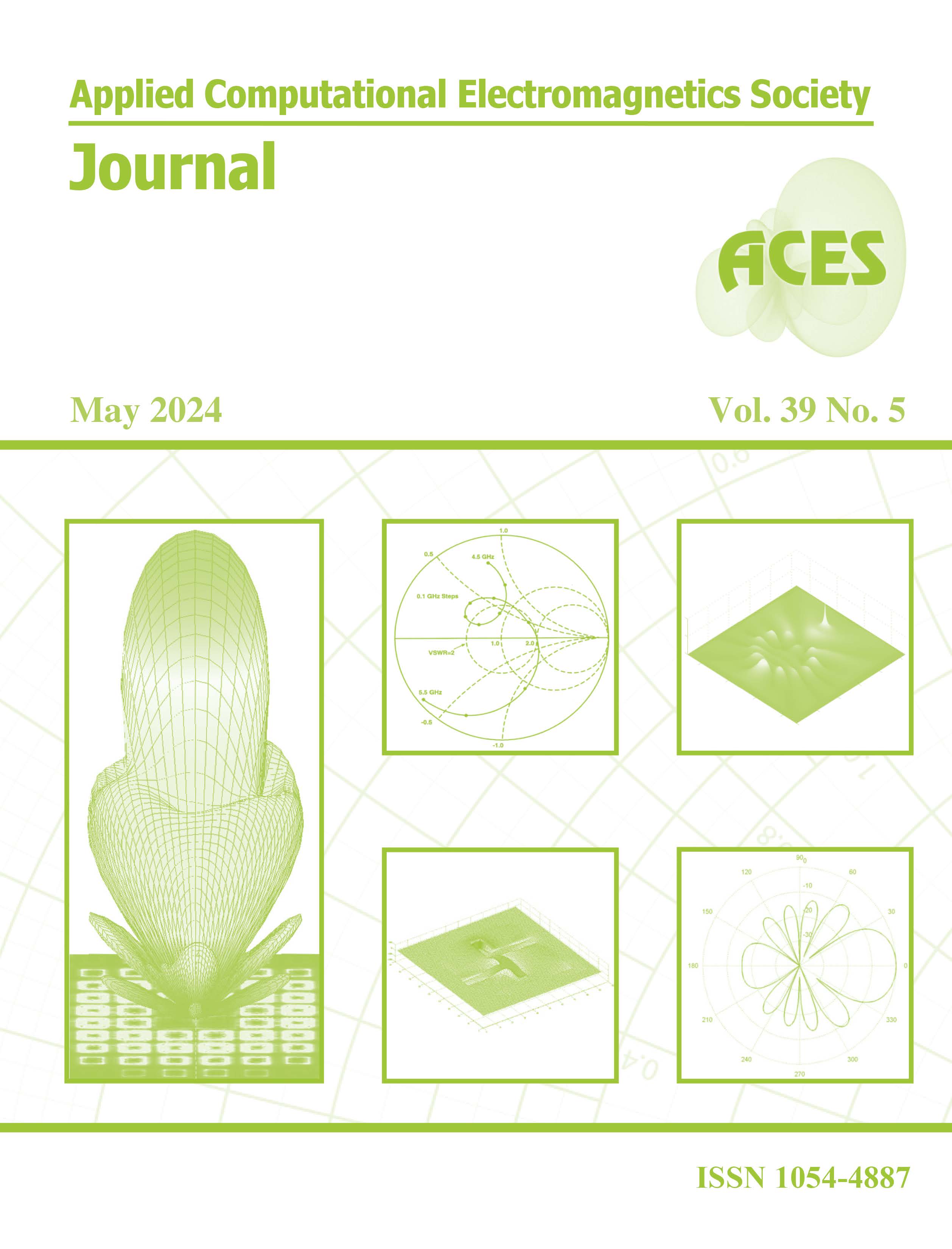Compact-size Lightweight Beam-reconfigurable ESPAR Antenna with Parasitic Elements for UAV Applications
##plugins.pubIds.doi.readerDisplayName##:
https://doi.org/10.13052/2024.ACES.J.390507关键词:
Beam-reconfigurable, compact, electronically steerable parasitic array radiator (ESPAR) antenna, PIN didoes, UAV applications摘要
This paper presents a compact lightweight beam-reconfigurable antenna system for unmanned aerial vehicles (UAVs). The antenna system consists of a central active monopole element surrounded by eight parasitic elements, which can be controlled using PIN diodes to switch the beam across four elevation angles and eight azimuth beams. This beam-reconfigurable antenna system has several advantages over traditional UAV antennas, including light weight, efficiency, and compactness. The antenna system operates at 5.09 GHz and achieves a measured peak gain of 4.55 dBi, with a remarkably low weight of 9 g and a size of 1.00λ0×1.00λ0×0.22λ0.
##plugins.generic.usageStats.downloads##
参考
F. Grimaccia, F. Bonfante, M. Battipede, P. Maggiore, and E. Filippone, “Risk analysis of the future implementation of a safety management system for multiple RPAS based on first demonstration flights,” Electronics, vol. 6, no. 3, pp. 50, 2017.
H. Baek and J. Lim, “Design of future UAV-relay tactical data link for reliable UAV control and situational awareness,” IEEE Communications Magazine, vol. 56, no. 10, pp. 140-150, 2018.
H. Ullah, N. G. Nair, A. Moore, C. Nugent, P. Muschamp, and M. Cuevas, “5G communication: An overview of vehicle-to-everything, drones, and healthcare use-cases,” IEEE Access, vol. 7, pp. 37251-37268, 2019.
R. Kovalchukov, D. Moltchanov, A. Samuylov, and A. Ometov, “Analyzing effects of directionality and random heights in drone-based mmwave communication,” IEEE Transactions on Vehicular Technology, vol. 67, no. 10, pp. 10064-10069, 2018.
S. A. R. Naqvi, S. A. Hassan, H. Pervaiz, and Q. Ni, “Drone-aided communication as a key enabler for 5G and resilient public safety networks,” IEEE Communications Magazine, vol. 56, no. 1, pp. 36-42, 2018.
M. S. Sharawi, O. A. Rawashdeh, and D. N. Aloi, “Performance of an embedded monopole antenna array in a UAV wing structure,” in Melecon 2010 - 2010 15th IEEE Mediterranean Electrotechnical Conference, Valletta, Malta, pp. 835-838, 2010.
X. Miao, W. Wan, Z. Duan, and W. Geyi, “Design of dual-mode arc-shaped dipole arrays for indoor base-station applications,” IEEE Antennas and Wireless Propagation Letters, vol. 18, no. 4, pp. 752-756, 2019.
C. U. Lee, G. Noh, B. Ahn, J.-W. Yu, and H. L. Lee, “Tilted-beam switched array antenna for UAV mounted radar applications with 360∘
coverage,” Electronics, vol. 8, no. 11, pp. 1240, 2019.
M. Taromaru and T. Ohira, “Electronically steerable parasitic array radiator antenna: Principle control theory and its applications,” Proc. Int. Union of Radio Science General Assembly, 2005.
R. Harrington, “Reactively controlled directive arrays,” IEEE Transactions on Antennas and Propagation, vol. 26, no. 3, pp. 390-395, 1978.
T. Ohira and K. Iigusa, “Electronically steerable parasitic array radiator antenna,” Electronics and Communications in Japan (Part II: Electronics), vol. 87, no. 10, pp. 25-45, 2004.
C. Sun, A. Hirata, T. Ohira, and N. C. Karmakar, “Fast beamforming of electronically steerable parasitic array radiator antennas: Theory and experiment,” IEEE Transactions on Antennas and Propagation, vol. 52, no. 7, pp. 1819-1832, 2004.
J. Costantine, Y. Tawk, S. E. Barbin, and C. G. Christodoulou, “Reconfigurable antennas: Design and applications,” Proceedings of the IEEE, vol. 103, no. 3, pp. 424-437, 2015.
S. V. S. Nair and M. J. Ammann, “Reconfigurable antenna with elevation and azimuth beam switching,” IEEE Antennas and Wireless Propagation Letters, vol. 9, pp. 367-370, 2010.
Z. Shi, R. Zheng, J. Ding, and C. Guo, “A novel pattern-reconfigurable antenna using switched printed elements,” IEEE Antennas and Wireless Propagation Letters, vol. 11, pp. 1100-1103, 2012.
M. Groth, M. Rzymowski, K. Nyka, and L. Kulas, “ESPAR antenna-based WSN node with DoA estimation capability,” IEEE Access, vol. 8, pp. 91435-91447, 2020.
M. Rzymowski and L. Kulas, “Two-row ESPAR antenna with simple elevation and azimuth beam switching,” IEEE Antennas and Wireless Propagation Letters, vol. 20, no. 9, pp. 1745-1749, 2021.
Y.-S. Choi and W.-S. Lee, “Reconfigurable beam switching antenna with horizontal parasitic element reflector (HPER) for UAV applications,” in 2020 IEEE International Symposium on Antennas and Propagation and North American Radio Science Meeting, Montreal, QC, Canada, pp. 433-434, 2020.
H. Kawakami and T. Ohira, “Electrically steerable passive array radiator (ESPAR) antennas,” IEEE Antennas Propag. Mag., vol. 47, no. 2, pp. 43-50, Apr. 2005.
R. Movahedinia, “Low-cost beam steerable antennas using parasitic elements,” Dissertation, Concordia University, 2018.
C. A. Balanis, Antenna Theory: Analysis and Design. Hoboken, NJ: Wiley, 2016.
C. G. Christodoulou, Y. Tawk, S. A. Lane, and S. R. Erwin, “Reconfigurable antennas for wireless and space applications,” Proceedings of the IEEE, vol. 100, no. 7, pp. 2250-2261, 2012.
D. Piazza, P. Mookiah, M. D’Amico, and K. R. Dandekar, “Experimental analysis of pattern and polarization reconfigurable circular patch antennas for MIMO systems,” IEEE Transactions on Vehicular Technology, vol. 59, no. 5, pp. 2352-2362, 2010.




